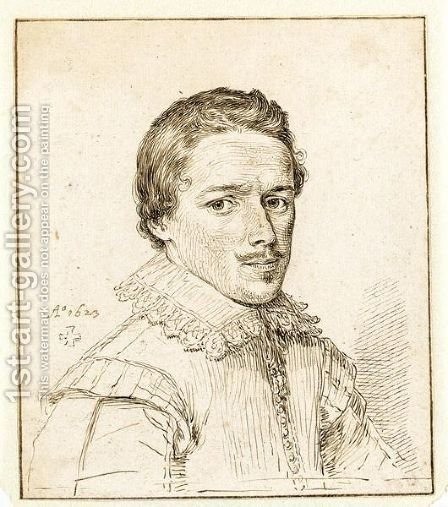David Bailly- Introduction
David Bailly was known for/as Flemish immigrant (Cornelius van der Voort). The birthplace of this artist is Leiden, Dutch Republic. And this artist is the supporter of Vanitas because every painting of this artist shows the style of Vanitas art movement. Paintings such as “Vanitas with self-portrait” and “Young Man with a Fur Hat,” are some famous paintings of this artist. This article covers essential sections- contents.
David Bailly- Biography
David Bailly (1584-1657) was a Dutch Golden Age painter known for his portraits and still life works. Here is a brief biography of his life:
- Early Life and Education: David Bailly was born in Leiden, Netherlands, in 1584. Not much is known about his early life and artistic training.
- Style and Subjects: Bailly specialized in portraiture and still life painting. His portraits often depicted notable individuals from the Dutch Republic, including scholars, artists, and aristocrats. He was also known for his vanitas still lifes, which conveyed symbolic messages about the fleeting nature of life and the inevitability of death.
- Technique and Influences: Bailly’s paintings showcased meticulous attention to detail and precise rendering of textures. He drew inspiration from both Flemish Baroque painters and the emerging genre of still life painting.
- Travels and Inspiration: Bailly embarked on various journeys across Europe, visiting countries such as France, England, and Germany. These travels exposed him to new artistic ideas and influences, shaping his artistic development.
- Significance and Legacy: While Bailly enjoyed recognition and esteem during his lifetime, his reputation diminished in the following centuries. It was only in the 20th century that his works were rediscovered and reappraised, leading to renewed appreciation for his skills and contributions.
- Notable Works: Bailly’s notable works include “Vanitas Still Life with a Portrait of a Young Woman” (circa 1651) and “Portrait of Jacob van Campen” (1628). These paintings exemplify his meticulous technique, delicate brushwork, and incorporation of symbolic themes.
- Death: David Bailly passed away in The Hague, Netherlands, in 1657, leaving a legacy as an accomplished painter of the Dutch Golden Age.
David Bailly’s skillful portraits and symbolic still lifes have gained renewed recognition in modern art history. His attention to detail, use of symbolism, and exploration of vanitas themes continue to captivate and inspire art enthusiasts today.
This artist was also interested in
- Post impressionism
- Fauvism
- Minimalism
David Bailly- 2 Frequently asked questions
Why are David Bailly paintings so costly?
The paintings of David Bailly remains in high demand, lovers like to purchase the painting of this artist. Following are some artworks of this artist.
- “Vanitas with self-portrait”
- “Young Man with a Fur Hat”
- “Portrait of Anthony de Wale (1573-1639). Professor of Theology at the University in Leiden”
You can search these artworks of these Vanitas artists on- Artplode ( artwork), Artfinder (Vanitas paintings), Saatchi Art, Society6, and Artnet. 2. If I want to compare the artwork of this Vanitas artist, then whom should be compared with David Bailly? There are so many artists of Vanitas. Perhaps, you may disagree with our comparison if you are an ardent follower of this artist. But in view of the area of activity such as Flemish immigrant (Cornelius van der Voort). We suggest you compare the artworks of David Bailly with the following artists:
- Bridget Riley
- Bronzino
- Camille Pissarro
- Diego Rivera
- Edvard Munch
David Bailly- Work

David Bailly (1584-1657) was a Dutch Golden Age painter known for his portraits and still life works. Here are some notable works by David Bailly:
- “Vanitas Still Life with a Portrait of a Young Woman” (circa 1651): This painting exemplifies Bailly’s expertise in creating vanitas still lifes. It features a young woman holding a skull, symbolizing the transient nature of life and the inevitability of death.
- “Portrait of Jacob van Campen” (1628): Bailly’s portrait of Jacob van Campen, a prominent Dutch architect, showcases his ability to capture the subject’s likeness and character. The painting demonstrates Bailly’s meticulous attention to detail and delicate brushwork.
- “Self-Portrait with Vanitas Symbols” (1651): Bailly’s self-portrait incorporates symbolic elements like an hourglass, a skull, and a butterfly, reflecting his contemplation of mortality and the fleeting nature of life.
- “Vanitas Still Life with a Skull and a Book” (1651): This still life composition features a skull resting on a book, surrounded by objects such as an hourglass, a musical instrument, and a flower. It explores Bailly’s fascination with vanitas themes.
- “Portrait of a Young Man with a Skull” (1627): Bailly’s portrait captures the contemplative gaze of a young man holding a skull, symbolizing the concept of memento mori, a reminder of the inevitability of death.
These artworks highlight Bailly’s technical skill, meticulous attention to detail, and exploration of symbolic themes, particularly within the context of vanitas still lifes. His portraits also demonstrate his ability to capture the essence and character of his subjects.
David Bailly- Painting
David Bailly (1584-1657) was a Dutch Golden Age painter known for his portraits and still life works. While there are not many well-known individual paintings by Bailly, he is primarily recognized for his skill in creating vanitas still life compositions. These works typically feature symbolic objects representing the transience of life, such as skulls, hourglasses, musical instruments, and books. Bailly’s meticulous attention to detail, delicate brushwork, and symbolic themes make his vanitas still lifes notable examples of the genre. Some of his well-known paintings include:
- “Vanitas Still Life with a Skull and a Book” (1651): This painting features a skull resting on a book, surrounded by objects like an hourglass, a lute, and a flower.
- “Vanitas Still Life with a Portrait of a Young Woman” (circa 1651): This composition showcases a young woman holding a skull, emphasizing the theme of mortality and the fleeting nature of life.
- “Vanitas Still Life with a Skull and a Sheet of Music” (1651): This still life includes a skull placed alongside a sheet of music, suggesting the ephemerality of human existence and the passing of time.
- “Vanitas Still Life with a Violin and a Skull” (1651): This work combines a skull, a violin, a book, and other objects to convey the vanitas theme, inviting contemplation on the transience of life and the inevitability of death.
These paintings exemplify Bailly’s expertise in the vanitas genre, with their meticulously rendered details, symbolic objects, and thought-provoking themes.
Know everything about David Bailly in short
David Bailly- Summary of this video
This video On David Bailly) gives a basic idea about this artist of Vanitas, David Bailly is an artist of this art form who devoted life for the sake of its renaissance (Vanitas art movement renaissance.
This YouTube video demonstrates the various aspects of David Bailly, such as contentos.
Thus, we see a connection with other art movements such as- Fauvism, Minimalism, and Momento3. Actually, these art movements have not been explained.
If you want to know about these art movements- Type (Fauvism, Minimalism, and momento3 or any name+ artandcrafter.com) on google, you will get information in a single click.
Although, there are many beautiful artworks of Vanitas.
And also, there are many artworks of David Bailly also such as “Vanitas with self-portrait”, “Young Man with a Fur Hat,” and “Portrait of Anthony de Wale (1573-1639). Professor of Theology at the University in Leiden”.
These paintings are very beautiful, and if you see Vanitas with self-portrait, you will notice the deepness of its depiction.
Another painting, such as “Young Man with a Fur Hat,” is another example of art mastership. That’s why, perhaps, you would get a different price on every website.
And you will also get an answer to the following question:-
Question– What do you love and hate the most about David Bailly? – YouTube Summary.
This categorization has been done according to Wikipedia data:- (Vanitas + David Bailly)
If you find something wrong about David Bailly, you may contact us through our comment section. David Bailly is the artist of Vanitas movement.
And this comparison has been made with these artists- Bridget Riley, Bronzino, Camille Pissarro, Diego Rivera, and Edvard Munch.
Everything is given on this website: Search ( artist + Artandcrafter.com), read and compare!
David Bailly- Information through Questions
- In this article, you got the answer of following questions- Frequently asked questions:-
- Who is David Bailly and why this artist is so famous?
- What are the notable artworks of David Bailly?
- What are David Bailly most famous artworks of? And why, these are so costly?
- What are some interesting facts about David Bailly?
- What are the most important sections of the life of David Bailly which anybody should know?
You knew about the most important section of the life of David Bailly, how the artistic career starts from the first part and ends at the second part. These important sections are:- contentos You read almost everything about this artist (David Bailly). But still, if you want to read more about Vanitas and David Bailly then you may read the following articles:-
- David Bailly – Biography | short notes | Top artworks.
- David Bailly – Life, paintings, contribution, death.
- David Bailly – Short notes | Know everything in seconds.
- David Bailly – Facts, Overview, complete life- At a glance.
These articles cover the whole artistic journey of this artist comprehensively.
David Bailly- Exhibition list
- Group Exhibitions of Dutch Golden Age Art: Bailly’s paintings are often included in group exhibitions focusing on Dutch Golden Age art. These exhibitions showcase works by various artists from the period, providing insights into the art and culture of the 17th century Netherlands.
- Museum Displays: Bailly’s works can be found in the collections of notable museums worldwide, including the Rijksmuseum in Amsterdam, the Mauritshuis in The Hague, and the Louvre Museum in Paris. These institutions occasionally exhibit his paintings as part of their permanent collections or temporary exhibitions.
- Thematic Exhibitions on Vanitas Still Life: Bailly’s expertise in vanitas still life compositions occasionally earns him a place in thematic exhibitions dedicated to the genre. These exhibitions explore the symbolism, themes, and artistic techniques employed by artists during the Dutch Golden Age.




